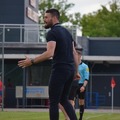Full backs defending in wide areas
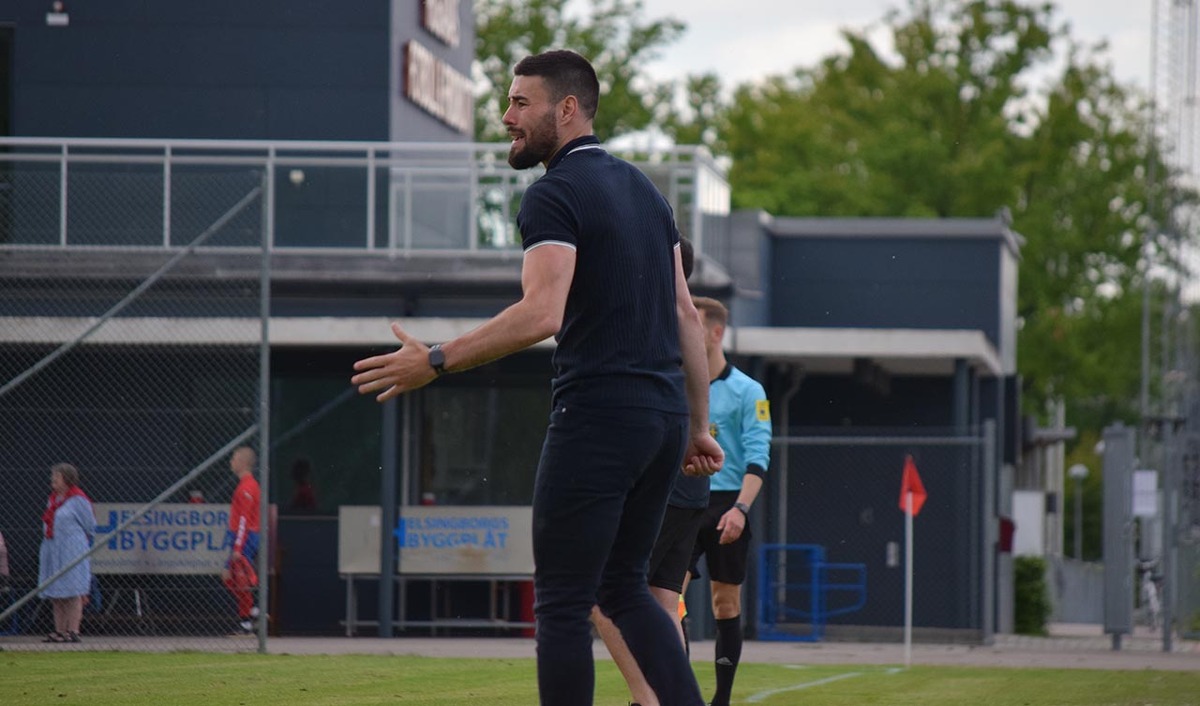
| Area | Quarter of the pitch |
| Equipment | Balls, bibs, cones, 4 mini target goals |
| No. of Players | At least 5 players |
| Session Time | 25 minutes |
This is a position-specific session aimed at making full backs better at defending in wide areas of the pitch.
It focuses on the kind of 1v1 and 1v2 defending that full backs tend to face in matches.
This is essential preparation because both defenders and attackers are exposed to 1v1s within the context of their positions, whilst the addition of a scoring system adds a further competitive edge to the activity.
We would run this practice on a day when the players can be exposed to a higher work load. It would be part of a second session on a training day, when players are performing position/unit- specific work.
“This training session focuses on the kind of 1v1 and 1v2 defending that full backs tend to face in matches”
DEFENDING IN WIDE AREAS
We set up on a quarter of a pitch with four mini target goals positioned as shown. We’re using five outfield players: three blue wingers and two red full backs.
Play starts with the coach playing a ball into a winger and that pass frees the full back to run out to defend, as shown [1a]. The winger can choose to try to take on the full back on the outside to cross into a target goal that represents the second six-yard box, or play the ball into an angled target goal inside the pitch which represents an incisive through pass to the edge of the penalty area, as shown [1b].
“The full back could try to match the winger for pace and prevent a cross being made, or could retreat towards goal to affect the cross”
[1a]

2. The red full back sprints out to defend, remembering to go ‘Fast, Slow, Sideways, Low’
[1b]
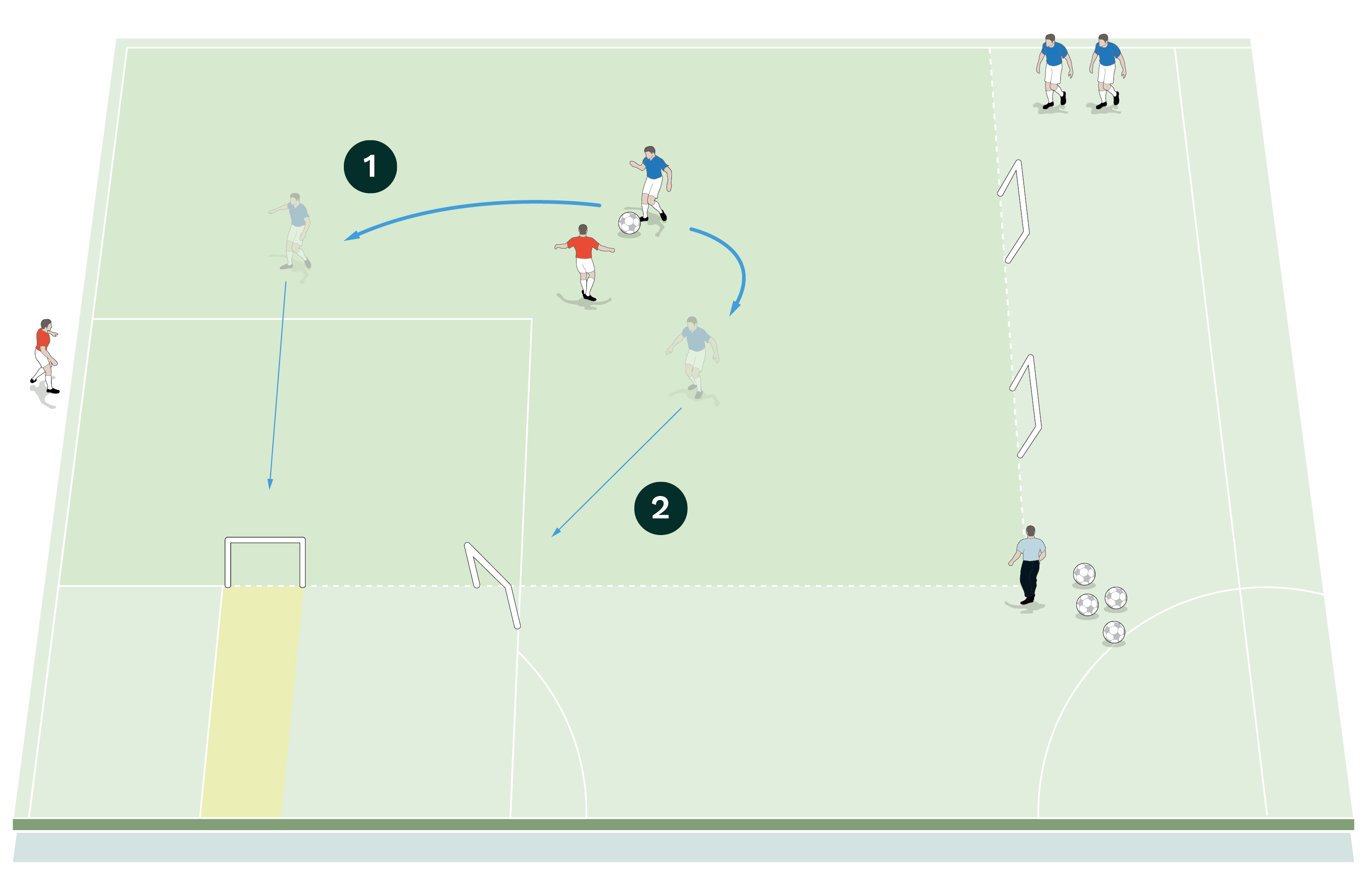
2. Alternatively, the winger could attempt to cut inside and play a decisive through pass into the angled target goal
[1c]
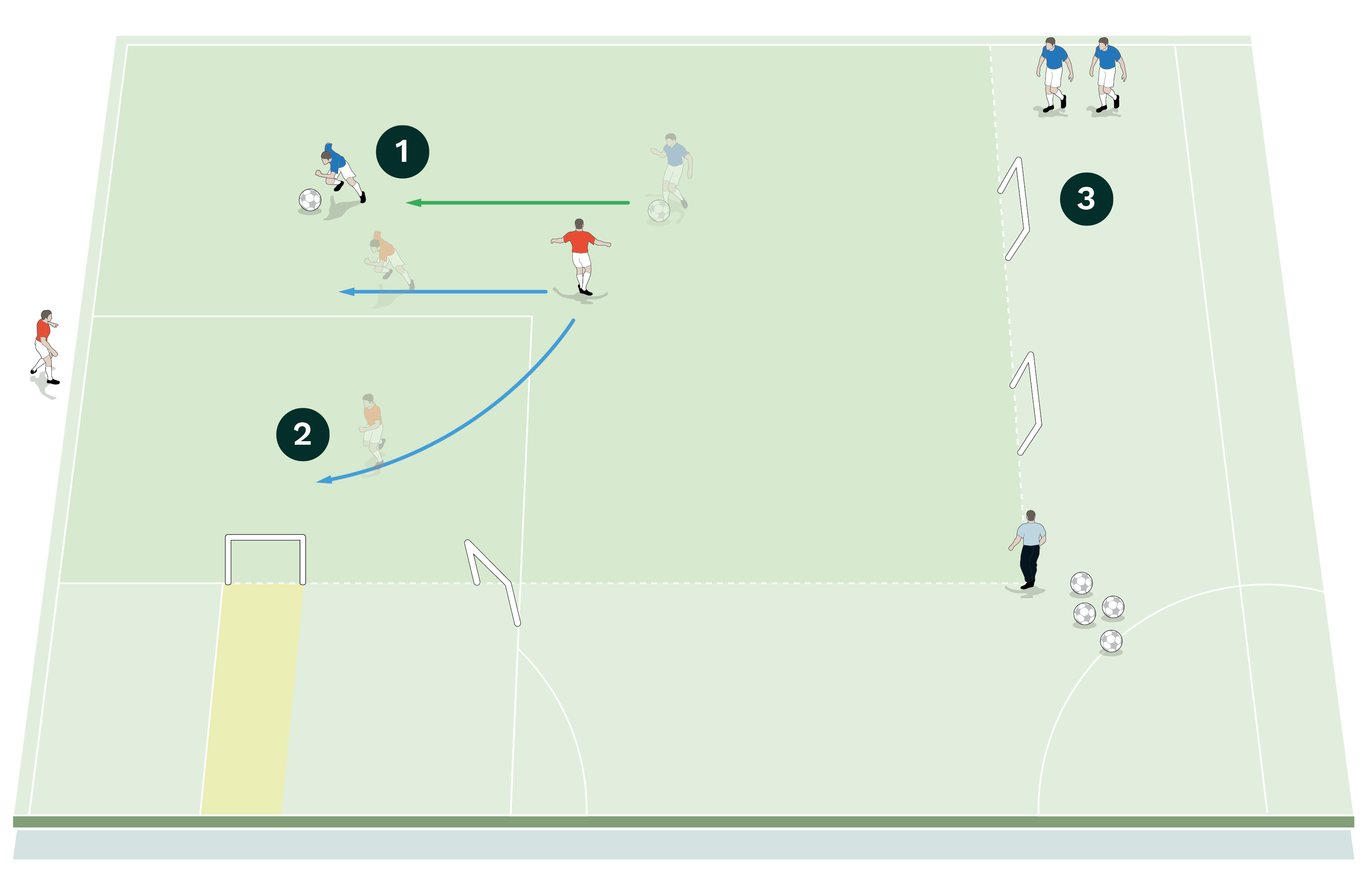
2. Alternatively, the full back could retreat towards goal and attempt to affect the cross
3. If the defender wins the ball, he plays out into one of the two target goals near the halfway line
The full back could try to match the winger for pace and attempt to prevent a cross being made, or could retreat towards goal and try to affect the cross, as shown [1c]. Should the full back win possession of the ball, he has two target goals to aim for with an out ball.
A new defender and a new attacker become live once the ball goes out of play and the coach serves in another ball.
A tally is kept to see whether the defending team or the attacking team scores the most goals, adding a competitive edge to the practice.
PROGRESSIONS
The activity can be easily progressed using the same set- up. As a first progression, after receiving the initial ball the winger can play a return pass to the coach and receive it back in a new area, using good off-the-ball movement to change the angle of approach, as shown [2a].
As a second progression, another blue attacker can join the winger in the attack, stepping in to create a 2v1 attack and giving the defender a new situation to defend against, as shown [2b]. The offside rule applies with both progressions.
[2a]
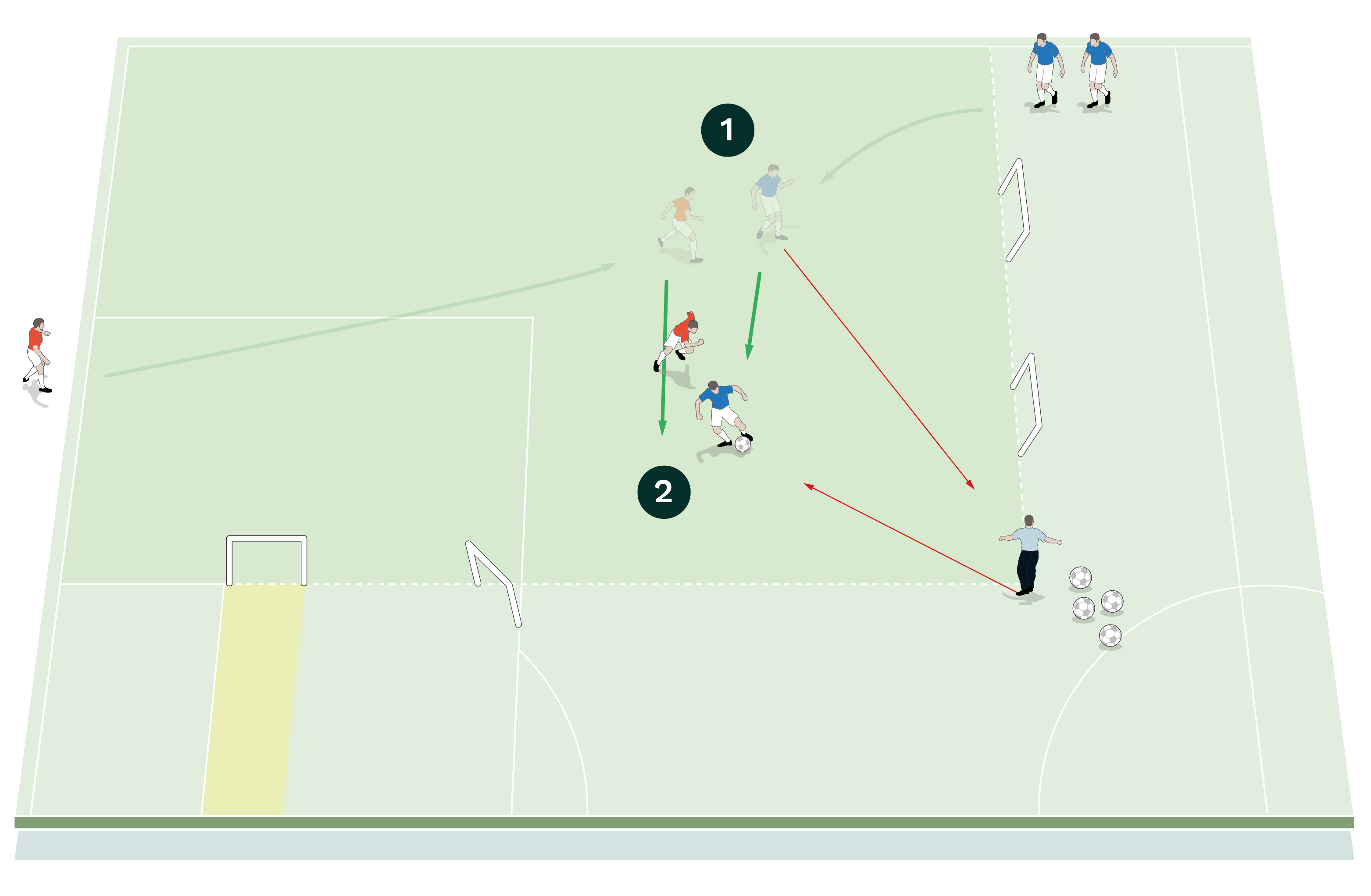
2. The red defender should be alert to the threat and cover the attacking movement of the blue winger
“As a first progression, after receiving the initial ball the winger can play a return pass to the coach and receive it back in a new area”
[2b]
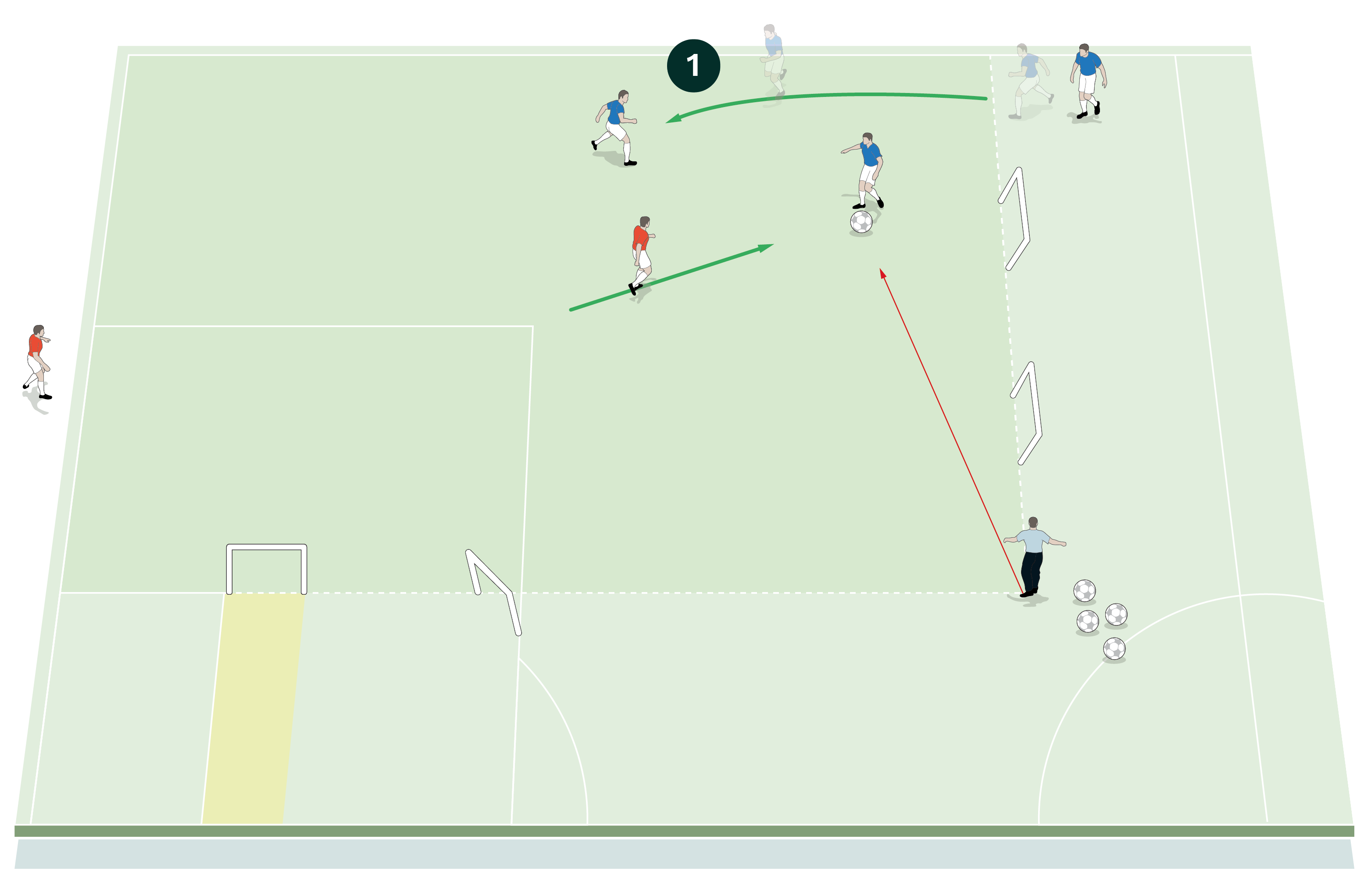
COACHING POINTS
What are the key things to look for?
The full back must try to read the first pass to the winger because it may be a pass that can be intercepted. If not, the full back should travel out to the winger quickly, remembering the FAST, SLOW, SIDEWAYS, LOW approach: the defender should travel quickly, slow down on the approach to the attacker and try to keep side on and low without overcommitting.
The full back should get his back foot in line with the ball to prevent the winger from coming inside the pitch but he should also remain balanced, ready to be explosive should the winger go down the outside and travel at pace.
We now want to see the full back making a decision: can he win the ball or the potential race with the winger in order to stop the cross, or does he need to recover at an angle towards his own goal to try to cut out the cross as best as possible.
During the 2v1 progression, it’s important for the full back to be patient and delay the attacker on the ball without committing. If the defender commits by diving in, it makes the decision for the attacking player easy. The full back should try and stay inside the pitch, encouraging the pass down the outside and then do their best to prevent or affect the cross into the target goal.
What are the typical mistakes players might make and how do I avoid them?
Typical mistakes include defenders not slowing down on the approach and overcommitting to get beaten. Encourage players to remember to go: FAST, SLOW, SIDEWAYS, LOW.
Sometimes defenders allow attackers inside to play dangerous incisive passes. To prevent this, it is important the defender gets his back foot in line with the ball to try to force the winger down the line, preventing him from coming inside.
How would I put this in a game situation?
This practice is transferable to the 11v11 game, where you can position yourself as a coach to work with the full backs within a full game.
Editor's Picks
Attacking transitions
Jesse Marsch
Deep runs in the final third
Fabian Hürzeler
Using the goalkeeper in build-up play
Ralph Hasenhüttl
Intensive boxes drill with goals
Andoni Iraola
Penetrating the final third
Ange Postecoglou
Creating and finishing
Pep Guardiola
My philosophy
Sir Alex Ferguson
Pressing initiation
Mauricio Pochettino
Compact team movement
Roberto Martinez
Coaches' Testimonials

Alan Pardew

Arsène Wenger

Brendan Rodgers

Carlos Carvalhal

José Mourinho

Jürgen Klopp

Pep Guardiola

Roy Hodgson

Sir Alex Ferguson

Steven Gerrard
Coaches' Testimonials

Gerald Kearney, Downtown Las Vegas Soccer Club

Paul Butler, Florida, USA

Rick Shields, Springboro, USA

Tony Green, Pierrefonds Titans, Quebec, Canada
Join the world's leading coaches and managers and discover for yourself one of the best kept secrets in coaching. No other training tool on the planet is written or read by the calibre of names you’ll find in Elite Soccer.
In a recent survey 92% of subscribers said Elite Soccer makes them more confident, 89% said it makes them a more effective coach and 91% said it makes them more inspired.
Get Monthly Inspiration
All the latest techniques and approaches
Since 2010 Elite Soccer has given subscribers exclusive insight into the training ground practices of the world’s best coaches. Published in partnership with the League Managers Association we have unparalleled access to the leading lights in the English leagues, as well as a host of international managers.
Elite Soccer exclusively features sessions written by the coaches themselves. There are no observed sessions and no sessions “in the style of”, just first-hand advice delivered direct to you from the coach.

